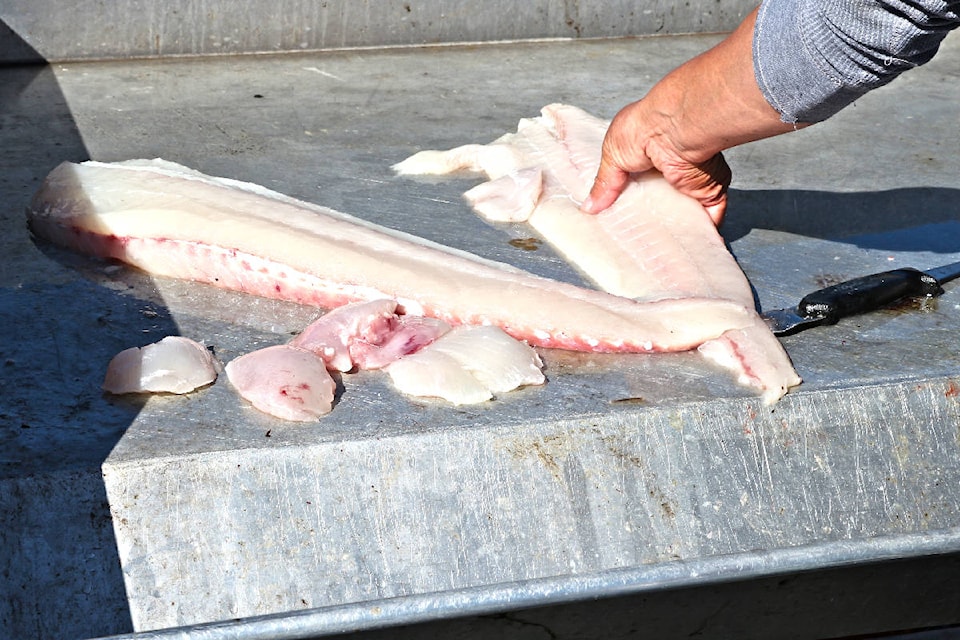Fifteen per cent of halibut is off the hook this year, as quotas drop for Canadian fishers on the B.C. coast.
The commercial halibut fishery opened on March 24 with total catch limit of 2,402 tonnes, down from 2,823 tonnes. But the real challenge is for the recreational fishery, which started March 1 with a catch limit of 421 tonnes, down from 507 tonnes. This year, recreational fishers are hoping to stay within their catch limits to avoid another early closure.
“There were two losses: for those who fish for sustenance, to have halibut for the winter, they did not have fish. And the charter boats, I know the guys I talked to all lost a number of charters because they had September halibut charters and they were suddenly shut down with no notice,” said David Lewis, chair of the Prince Rupert Sports Advisory Board.
READ MORE: For the first time in five years, recreational halibut fishing closes early for the season
Historically, the recreational fishery for halibut remains open until Dec. 31, but last year, the catch limit was reached by Sept. 6. The only other option for charter businesses was to lease halibut quota from the commercial fishery. As a result, the International Halibut Commission reported 1. 8 tonnes, or 4,000 pounds, of the commercial quota was leased to the recreational fishery in Canada.
The drop in quota for the Pacific Coast isn’t entirely new, said Adam Keizer, Fisheries and Oceans Canada (DFO) groundfish manager for the region.
“There have been a number of reductions in the available catch limits coast-wide from Northern California to Alaska for a number of years. This is largely the result of changing biology of the stock,” Keizer said.
“We’ve seen decreasing size-at-age. Fish are smaller today than 20 years ago. That reduces the available biomass for harvest but also the stock had less harvest available in general, less productive in recent years.”
Typically, the International Halibut Commission meets annually to determine the catch limits of the year for Canada and the U.S. but this year they couldn’t come to an agreement and determined the 2017 limits would be remain. However, both Canada and the U.S. indicated that they would pursue lower catch limits through domestic regulations.
As a result, the annual recreational quota has decreased by 17 per cent. The Sports Advisory Board is working on a plan that involves smaller catch sizes to avoid early closures.
“The quota shrunk and we shrunk the size of the fish hoping that will get us through,” Lewis said.
The advisory board proposed to reduce the maximum size limit for the larger fish from the 133cm to 115cm, yet keep the size for the small fish at 80cm, and the regulations will still be for one fish per day, two in possession, six annually.
DFO hasn’t signed off on the plan yet. Recreational fishing for halibut reopened on March 1 but DFO is still deciding on a new set of management measures that will come into effect April 1 when the new licences are issued.
Rockfish concerns
On top of size reductions, recreational fishers may also face more restrictions due to yelloweye and other rockfish.
Rockfish live for over 100 years, and don’t reach maturity until they’re teenagers, Keizer explained over the phone. They are susceptible to overharvest because it takes them a long time to reproduce.
“The other issue, rockfish suffer severe barotrauma, much like the bends,” he said. “They suffer this because their swim bladder is not attached to oesophaguses.”
When they are brought to the surface, they can’t equilibrate the pressure — their eyes bulge from their head, their oesophagus and stomach bulges from their mouth.
“The department, for all intents and purposes, estimates there is no catch and release for rockfish. Every released rockfish is dead,” Keizer said.
READ MORE: DFO contemplating sweeping North Coast salmon fishery closure
DFO estimates significant declines of rockfish over the past 20 years and the department is working on a rebuilding strategy to recover yelloweye stocks. The federal regulator is considering zero retention of yelloweye rockfish and a maximum of three rockfish per day.
“Too soon too quick to do it. If they haven’t made a decision yet, it’s hard to put one on the table for April 1. Not everyone is going to be ready. There needs to be an education period,” Lewis said.
Commercial fishery
Not everyone is concerned about the lowered quotas. For long-time fisherman Sverre Hauknes, he said it doesn’t make much difference.
“Less fish to sell but in the scheme of things it’s not the end of the world,” he said.
He’s busy catching herring now, and doesn’t plan to fish for halibut until the fall.
For Haida Gwaii-based fisherman, William Davis, he’s starting to fish for halibut in April.
“It means less fish for all of us. I troll for salmon and that doesn’t look good also,” he said.
